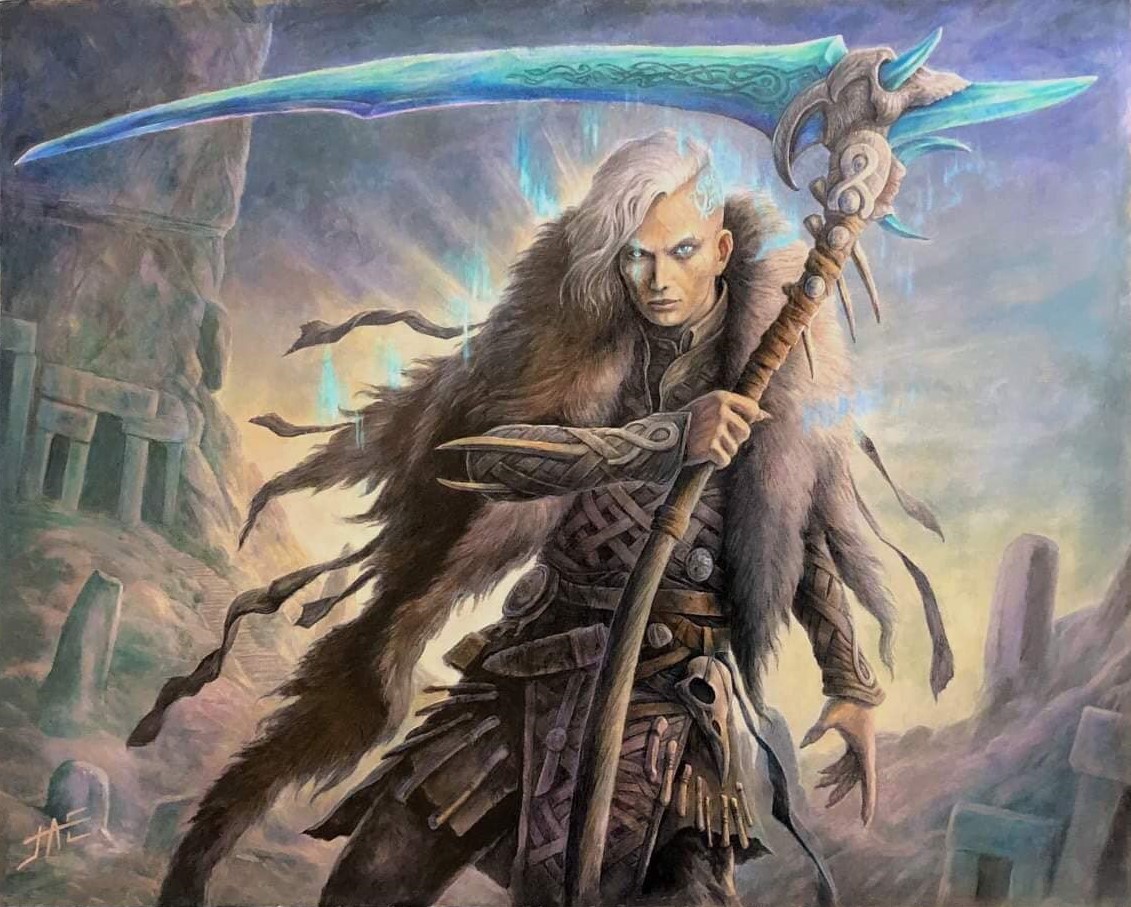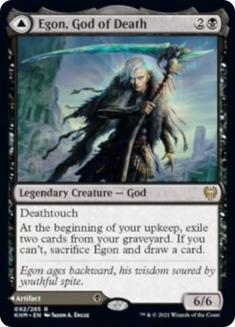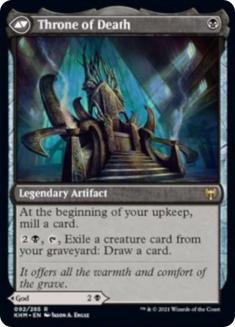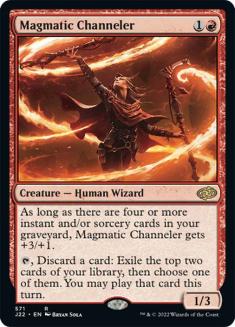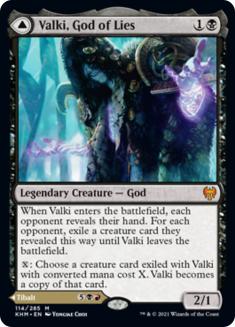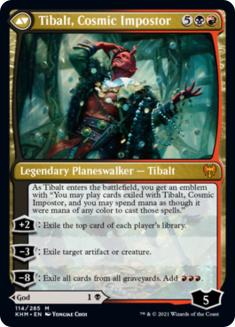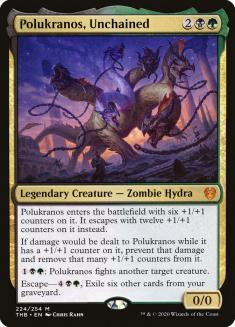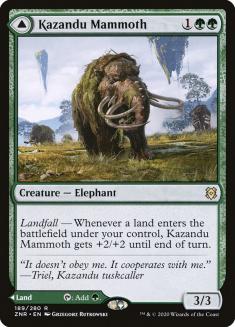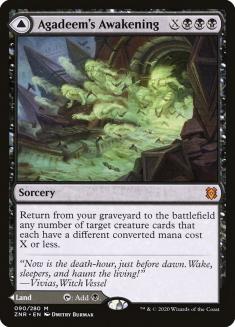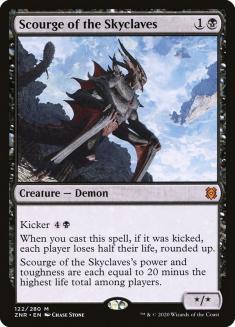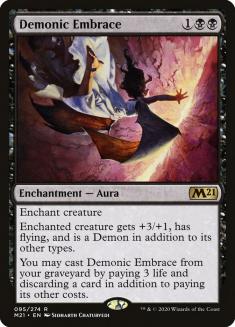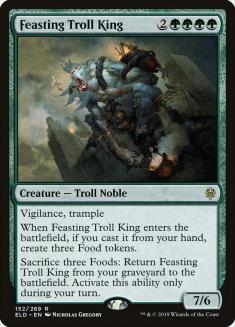What do we say to the God of Death?
Apparently, it’s something along the lines of “Get in my deck.”
DFCs are fun, especially when you’ll be casting each side with relatively equal frequency. The amount of agency you feel like you have over any given turn or game is tremendous and tends to make the games more fun. Egon, God of Death is a perfect example.
Both halves of Egon, God of Death want you to fill your graveyard and use it, which speaks to me. My love for these types of strategies runs deep and I hope that becomes apparent when you see some of the decklists in this article.
If you’re able to keep your graveyard stocked, a 6/6 deathtouch is obviously powerful. Thankfully, Egon should end the game quickly, so you don’t have to worry about keeping it around in perpetuity. There’s no shortage of Standard cards that improve when you’ve got a large body, so the 6/6 body will typically have some utility outside of their size.
Thone of Death might not be a card the average Magic player would get excited about during preview season. For better or worse, I am not the average Magic player. A Rotting Regisaur wannabe is exciting but I’m far more excited about a cheap artifact that can fill my graveyard and double as a card-drawing engine in the late-game. Any broken deck or synergy typically involves a cheap enabler and that’s exactly what Throne of Death is.
To top it off, you have the option for a 6/6 creature. Both halves also work well together, so you’re actively excited to draw multiples. I also love that if you can’t pay the upkeep cost on Egon, you still get to draw a card. This card is powerful and flexible, and doesn’t have much in the way of a downside.
It’s perfect, just like my first decklist.
Creatures (20)
- 4 Bonecrusher Giant
- 2 Ox of Agonas
- 4 Mire Triton
- 4 Kroxa, Titan of Death's Hunger
- 2 Valki, God of Lies
- 4 Egon, God of Death
Planeswalkers (2)
Lands (23)
Spells (15)

Finally, a Rakdos Pathway! For the longest time, Rakdos was plagued by a mediocre manabase. For a color combination that tends to want to use its mana each turn, having an abundance of lands that enter the battlefield tapped directly led to too many game losses. Not today, Temple of Malice!
I’m playing four copies of Egon, God of Death because I want to draw it early and often. Two copies is optimal so you can both sides going. Rakdos Midrange didn’t have a plethora of great one-drops, so we’re sacrificing very little by trying to cast Throne of Death on Turn 1 every game. The abundance of three-drops also means you’ll want to cast Throne of Death before Egon. Having a cheap enabler will help empty your hand for Ox of Agonas and enable faster Kroxa, Titan of Death’s Hunger escapes.
If Throne of Death were a card on its own, it would be worthy of consideration for Rakdos Midrange. Between Blightstep Pathway and Throne of Death, Rakdos is able to be far more mana efficient than it was before.
I like Magmatic Channeler, especially to fill the graveyard for Egon, but maybe you don’t need the help anymore. Instead, we have Valki, God of Lies, which will see a substantial amount of play in Standard. The front side is a solid disruptive, aggressive creature that can also become scary. It’s particularly brutal in Kroxa mirrors. Tibalt, Cosmic Impostor won’t get cast nearly as often as Valki, although it will likely win most games where it is. There isn’t much removal for planeswalkers and it has a ton of loyalty, so it will rarely die.
Being able to use Valki as a way to disrupt your opponent’s curve or borrow their companion once they put it into their hand makes Valki rather flexible. You could easily play more copies, although it’s more of a value-add for this graveyard-centric version of Rakdos.
One of the biggest questions for a deck like this is how many graveyard payoffs we want alongside Egon. Having Kroxa and Ox of Agonas in the same deck was awkward at times. If you have Egon on the battlefield for a couple of turns, you’re probably winning, but your graveyard is likely gone. I’m close to maximizing the amount of self-milling you can do and think it’s important to do so in Rakdos.
For the most part, you want an enabler and a payoff and you’ll have twelve copies of each with this build. Egon counting as both is certainly helpful. If you draw multiple payoffs but can’t use them all, at least you have the option to choose what would be best for your situation.
The singleton Kazuul’s Fury is a solid addition with so many six-power creatures. Kroxa and Stomp get in some fine chip damage, which means it’s not difficult to Fling your opponent to death.
Honestly, Rakdos is looking incredibly strong. Valki, Blightstep Pathway, and Egon add some much-needed power to the archetype. Your mana is better, you get more options for both the early and late-game, and your clock is stronger. It’s huge upgrades all around.
Creatures (27)
- 2 Scavenging Ooze
- 4 Foulmire Knight
- 4 Lovestruck Beast
- 2 Murderous Rider
- 4 Edgewall Innkeeper
- 4 Mire Triton
- 1 Polukranos, Unchained
- 2 Kazandu Mammoth
- 4 Egon, God of Death
Lands (23)
Spells (10)

Golgari is awkward.
The logic behind this deck was having Egon as another enabler for The Great Henge. Golgari Adventures didn’t naturally fill its graveyard but gets much better at it with some small adjustments. Throne of Death can be a nice engine in longer games and can fill your graveyard for things like Agadeem’s Awakening.
Sadly, there aren’t many good ways to take advantage of a full graveyard in Golgari. However, there are several mediocre ways to take advantage of a stocked graveyard, such as Polukranos, Unchained.
I generally like Tymaret Calls the Dead but it doesn’t make the cut here. The Great Henge requires powerful three-drops to enable it, so we’re too clogged at that point on the curve. You could use the additional graveyard fueling but the deck is functional without it. You want to curve Throne of Death or Mire Triton into Egon to enable The Great Henge. Tymaret Calls the Dead doesn’t work as an enabler for that sequence, so it was cuttable.
Is Egon in this deck stronger than playing more Kazandu Mammoths? My rationale was that having Agadeem’s Awakenings that could return Edgewall Innkeeper made it worth it, although that might not be the case. Ideally, we’d have something else to take advantage of our graveyard.
You could make a good case for removing the Adventures aspect of the deck but then you’d be better off playing Rakdos. Green has plenty of graveyard cards and self-mill but none of them compare to Kroxa and Ox of Agonas. Polukranos, Unchained exists but I’ve never been a fan. Nissa of Shadowed Boughs is reasonable but you’re rarely going to be returning anything game-breaking. Having access to something marginal like Skyclave Shade in the Rakdos decks is quite appealing and could potentially be what we should be doing here.
You could play Valki and some Pathways to splash Tibalt. If you wanted to go harder, you could play Bonecrusher Giant as well. A single copy of Bonders’ Enclave could be solid but the manabase is demanding. You have several one-drops in green and black, so each colored mana matters.
Masked Vandal is excellent and will show up in many places. If you’re milling yourself, getting full value should be trivial.
Creatures (23)
- 2 Stonecoil Serpent
- 4 Mire Triton
- 4 Serrated Scorpion
- 4 Scourge of the Skyclaves
- 3 Skyclave Shade
- 4 Egon, God of Death
- 2 Duskwielder
Lands (17)
Spells (20)

The Great Henge isn’t the only way to take advantage of Egon’s 6/6 body. Getting redundancy on big creatures with Scourge of the Skyclaves is awesome. It means that leaning into something like Demonic Embrace, which also benefits from self-mill, is more worthwhile. It’s only a matter of time before Scourge of the Skyclaves is in a Tier 1 deck.
Serrated Scorpion and Mire Triton can potentially put you over twenty life, which isn’t ideal for Scourge of the Skyclaves. The DFCs can help keep you below twenty, which is why I’m playing off-color Shatterskull Smashing. I could easily see more copies.
Creatures (20)
- 4 Bonecrusher Giant
- 2 Stormfist Crusader
- 4 Mire Triton
- 1 Kroxa, Titan of Death's Hunger
- 3 Scourge of the Skyclaves
- 2 Skyclave Shade
- 4 Egon, God of Death
Lands (18)
Spells (22)

Adding a color to your Scourge of the Skyclaves deck has trade-offs. Without one-drops, we’re certainly worse at enabling Scourge of the Skyclaves on Turn 2. Stormfist Crusader is a cool way to enable Scourge both ways, albeit a little later than you’d prefer. On the other hand, we gain Embercleave, which is incredible with both of our huge threats. It’s basically a two-card combo, albeit one that clearly lacks some supporting pieces.
Creatures (22)
- 4 Gilded Goose
- 4 Feasting Troll King
- 4 Emry, Lurker of the Loch
- 2 Stonecoil Serpent
- 4 Kazandu Mammoth
- 4 Egon, God of Death
Lands (23)
Spells (15)

Man, I hope this deck is playable.
The goal is to make some artifacts, mill yourself, reanimate Feasting Troll King, and bury your opponent in card advantage. Unfortunately, there’s not a great discard outlet in Sultai. Naturally drawing Feasting Troll King isn’t ideal but it will be eventually castable.
Ideally, our manabase would be stronger, we’d have more interaction, and maybe a better way to filter through our redundant combo pieces. Unfortunately, we aren’t quite there yet.
Finally, we can take a look at Egon in older formats.
Creatures (19)
- 4 Bomat Courier
- 2 Scrapheap Scrounger
- 4 Emry, Lurker of the Loch
- 2 Ox of Agonas
- 3 Kroxa, Titan of Death's Hunger
- 4 Egon, God of Death
Lands (21)
Spells (20)

The hope here is that Grixis Emry can provide a disruptive aggro deck with an engine, similarly to the Rakdos Arcanist decks. Obviously you’re going to have trouble with Leyline of the Void but Grafdigger’s Cage and the like are manageable.
In older formats, mana efficiency tends to be key, and this deck is excellent in that category. The question is whether or not these cheap cards can stand up to what the rest of the format is doing. For a sizeable portion of the metagame, the answer is probably yes, but it won’t be great against everyone.
Regardless, this deck is close. Maybe it’s as simple as moving into green for Uro, Titan of Nature’s Wrath. You could potentially keep Bomat Courier with Spire of Industry, Chromatic Sphere, and various multicolored lands. Ox of Agonas is a stronger payoff for a deck with almost entirely one-drops, so it’s a close call. Regardless, Emry, Lurker of the Loch is almost there and it wouldn’t surprise me if Throne of Death finally puts it over the top.

